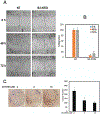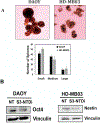Suppression of STAT3 NH2 -terminal domain chemosensitizes medulloblastoma cells by activation of protein inhibitor of activated STAT3 via de-repression by microRNA-21
- PMID: 29280516
- PMCID: PMC6132241
- DOI: 10.1002/mc.22778
Suppression of STAT3 NH2 -terminal domain chemosensitizes medulloblastoma cells by activation of protein inhibitor of activated STAT3 via de-repression by microRNA-21
Abstract
Medulloblastoma (MB) is a malignant pediatric brain tumor with poor prognosis. Signal transducers and activators of transcription-3 (STAT3) is constitutively activated in MB where it functions as an oncoprotein, mediating cancer progression and metastasis. Here, we have delineated the functional role of activated STAT3 in MB, by using a cell permeable STAT3-NH2 terminal domain inhibitor (S3-NTDi) that specifically perturbs the structure/function of STAT3. We have implemented several biochemical experiments using human MB tumor microarray (TMA) and pediatric MB cell lines, derived from high-risk SHH-TP53-mutated and MYC-amplified Non-WNT/SHH tumors. Treatment of MB cells with S3-NTDi leads to growth inhibition, cell cycle arrest, and apoptosis. S3-NTDi downregulated expression of STAT3 target genes, delayed migration of MB cells, attenuated epithelial-mesenchymal transition (EMT) marker expressions and reduced cancer stem-cell associated protein expressions in MB-spheres. To elucidate mechanisms, we showed that S3-NTDi induce expression of pro-apoptotic gene, C/EBP-homologous protein (CHOP), and decrease association of STAT3 to the proximal promoter of CCND1 and BCL2. Of note, S3-NTDi downregulated microRNA-21, which in turn, de-repressed Protein Inhibitor of Activated STAT3 (PIAS3), a negative regulator of STAT3 signaling pathway. Furthermore, combination therapy with S3-NTDi and cisplatin significantly decreased highly aggressive MYC-amplified MB cell growth and induced apoptosis by downregulating STAT3 regulated proliferation and anti-apoptotic gene expression. Together, our results revealed an important role of STAT3 in regulating MB pathogenesis. Disruption of this pathway with S3-NTDi, therefore, may serves as a promising candidate for targeted MB therapy by enhancing chemosensitivity of MB cells and potentially improving outcomes in high-risk patients.
Keywords: MYC; PIAS3; STAT3; medulloblastoma; miR-21.
© 2017 Wiley Periodicals, Inc.
Figures














Similar articles
-
STAT3 in medulloblastoma: a key transcriptional regulator and potential therapeutic target.Mol Biol Rep. 2022 Nov;49(11):10635-10652. doi: 10.1007/s11033-022-07694-6. Epub 2022 Jun 18. Mol Biol Rep. 2022. PMID: 35716286 Review.
-
The intracellular delivery of a recombinant peptide derived from the acidic domain of PIAS3 inhibits STAT3 transactivation and induces tumor cell death.Mol Cancer Res. 2010 Apr;8(4):539-53. doi: 10.1158/1541-7786.MCR-09-0417. Epub 2010 Apr 6. Mol Cancer Res. 2010. PMID: 20371673
-
SHP2, SOCS3 and PIAS3 Expression Patterns in Medulloblastomas: Relevance to STAT3 Activation and Resveratrol-Suppressed STAT3 Signaling.Nutrients. 2016 Dec 27;9(1):3. doi: 10.3390/nu9010003. Nutrients. 2016. PMID: 28035977 Free PMC article.
-
Ascochlorin, an isoprenoid antibiotic inhibits growth and invasion of hepatocellular carcinoma by targeting STAT3 signaling cascade through the induction of PIAS3.Mol Oncol. 2015 Apr;9(4):818-33. doi: 10.1016/j.molonc.2014.12.008. Epub 2015 Jan 5. Mol Oncol. 2015. PMID: 25624051 Free PMC article.
-
Pre-clinical investigation of STAT3 pathway in bladder cancer: Paving the way for clinical translation.Biomed Pharmacother. 2021 Jan;133:111077. doi: 10.1016/j.biopha.2020.111077. Epub 2020 Dec 4. Biomed Pharmacother. 2021. PMID: 33378975 Review.
Cited by
-
STAT3 in medulloblastoma: a key transcriptional regulator and potential therapeutic target.Mol Biol Rep. 2022 Nov;49(11):10635-10652. doi: 10.1007/s11033-022-07694-6. Epub 2022 Jun 18. Mol Biol Rep. 2022. PMID: 35716286 Review.
-
Noncoding RNAs involved in the STAT3 pathway in glioma.Cancer Cell Int. 2021 Aug 23;21(1):445. doi: 10.1186/s12935-021-02144-y. Cancer Cell Int. 2021. PMID: 34425834 Free PMC article. Review.
-
The Plant-Derived Compound Resveratrol in Brain Cancer: A Review.Biomolecules. 2020 Jan 19;10(1):161. doi: 10.3390/biom10010161. Biomolecules. 2020. PMID: 31963897 Free PMC article. Review.
-
Histone chaperone FACT complex inhibitor CBL0137 interferes with DNA damage repair and enhances sensitivity of medulloblastoma to chemotherapy and radiation.Cancer Lett. 2021 Nov 1;520:201-212. doi: 10.1016/j.canlet.2021.07.020. Epub 2021 Jul 14. Cancer Lett. 2021. PMID: 34271103 Free PMC article.
-
STAT3 is required for Smo-dependent signaling and mediates Smo-targeted treatment resistance and tumorigenesis in Shh medulloblastoma.Mol Oncol. 2022 Feb;16(4):1009-1025. doi: 10.1002/1878-0261.13097. Epub 2021 Sep 25. Mol Oncol. 2022. PMID: 34482626 Free PMC article.
References
-
- Gilbertson RJ, Ellison DW: The origins of medulloblastoma subtypes. Annu Rev Pathol 2008, 3:341–365. - PubMed
-
- Bromberg JF: Activation of STAT proteins and growth control. Bioessays 2001, 23(2):161–169. - PubMed
-
- Darnell JE, Jr., Kerr IM, Stark GR: Jak-STAT pathways and transcriptional activation in response to IFNs and other extracellular signaling proteins. Science 1994, 264(5164):1415–1421. - PubMed
Publication types
MeSH terms
Substances
Grants and funding
LinkOut - more resources
Full Text Sources
Other Literature Sources
Research Materials
Miscellaneous

